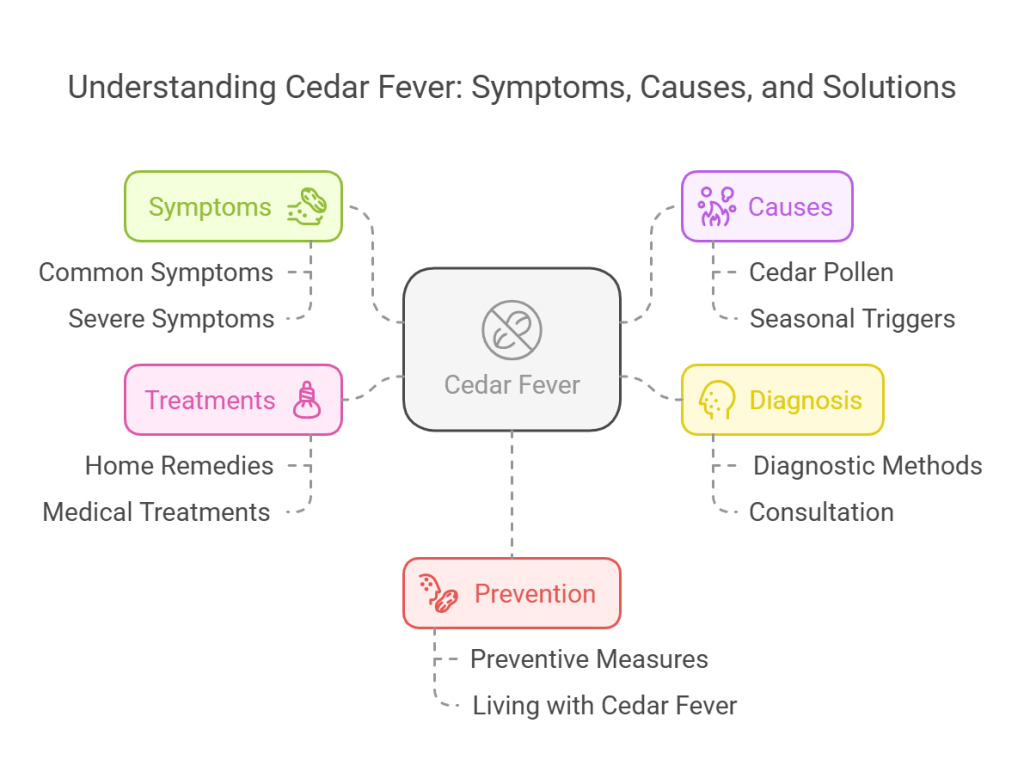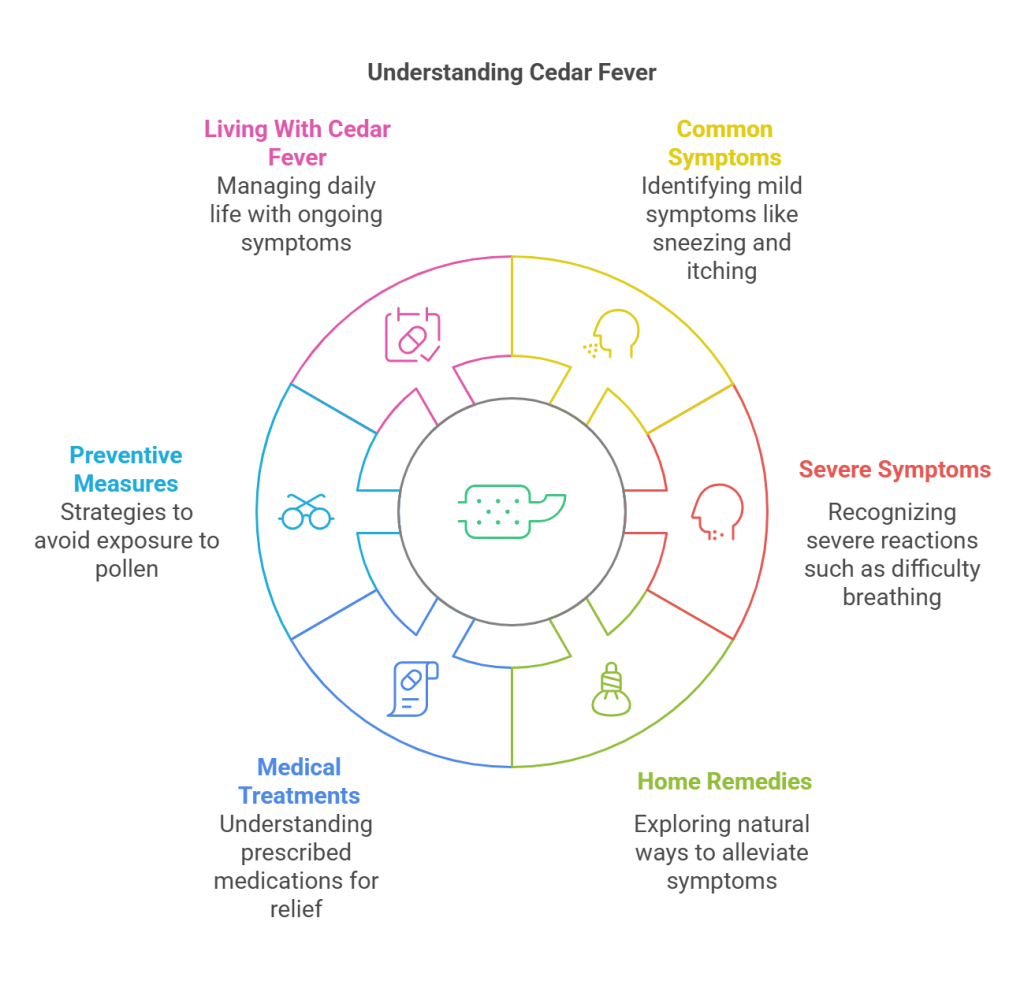Cedar fever is a seasonal allergy caused by pollen from mountain cedar trees. Symptoms can mimic the flu or a cold, making it hard to identify.
Cedar fever strikes during winter, particularly in areas with mountain cedar trees. Unlike typical winter illnesses, cedar fever results from an allergic reaction to pollen. Symptoms include itchy eyes, runny nose, and sneezing. This condition often affects people living in regions where mountain cedar trees are prevalent, such as Texas.
Understanding cedar fever is crucial for managing symptoms effectively. Knowing how to distinguish it from other ailments can help you seek proper treatment and relief. In this blog, we will explore the signs and symptoms of cedar fever, helping you determine if you might be experiencing this seasonal allergy.
Introduction To Cedar Fever
Cedar Fever causes allergy symptoms like sneezing, runny nose, and itchy eyes. Symptoms often peak during winter. Identifying these signs helps determine if you have Cedar Fever.
What Is Cedar Fever?
Cedar fever is an allergy. It comes from cedar tree pollen. This pollen spreads in winter. It can cause sneezing, itchy eyes, and a runny nose. Some people feel very tired. Others might have a headache. This happens most in places with many cedar trees. The symptoms can be severe. They often feel like a cold. But it is not a virus.
Prevalence And Impact
Many people suffer from cedar fever. It is common in certain areas. Texas is one of them. Cedar pollen is very strong. It can travel far with the wind. This means many people can be affected. Cedar fever can make life hard. People may miss work or school. Some might need medicine to feel better. It is important to know if you have cedar fever.

Common Symptoms
Nasal congestion is a key symptom of cedar fever. Your nose feels stuffy. Breathing through the nose becomes hard. The nose may run a lot. This can be annoying and tiring. You might also sneeze a lot. Sneezing is often sudden and strong.
Itchy eyes and throat are also common. Eyes might feel dry and scratchy. They can turn red and watery. Rubbing them can make it worse. Your throat may itch too. This can cause you to cough. Drinking water helps but the itch may stay. These symptoms are uncomfortable and affect daily life.
Severe Symptoms
Feeling tired all the time could be a sign. Lack of energy is common. Weakness in the body is another symptom. These feelings can make daily tasks hard. It’s important to rest. Drink lots of water. Proper sleep helps too. Avoiding stress can also help.
Fever is a key sign of cedar fever. Feeling cold even when warm is common. Chills can make you shiver. These symptoms often come together. They can last for days. It’s important to stay warm. Use blankets if needed. Drink warm liquids to feel better.
Causes Of Cedar Fever
Cedar fever is caused by pollen from mountain cedar trees. Symptoms include sneezing, itchy eyes, and a runny nose. These symptoms often appear in winter, during the cedar tree pollination period.
Cedar Pollen
Cedar trees release pollen during the winter. This pollen can cause many allergies. Some people are very sensitive to cedar pollen. It can make them feel very sick. Symptoms can include sneezing, coughing, and a runny nose. Eyes may get red and itchy. The pollen is very fine and spreads easily. Even a little wind can carry it far. This makes it hard to avoid. Staying indoors can help. Using air filters can also reduce pollen inside.
Seasonal Triggers
Cedar fever happens in winter. This is when cedar trees pollinate. The season usually starts in December. It can last until February. Cold weather can make symptoms worse. Dry, windy days are the hardest. The pollen counts are highest then. Rain can help lower pollen in the air. Knowing the season helps you prepare. Check pollen forecasts daily. Plan outdoor activities when counts are low.

Diagnosing Cedar Fever
Doctors use medical tests to find out if you have cedar fever. These tests help identify allergies and other issues. One common test is a blood test. This test looks for certain antibodies in your blood.
Allergy testing can show if cedar pollen bothers you. A skin prick test is often used. In this test, a small amount of cedar pollen is placed on your skin. If a bump or redness appears, you might be allergic. Blood tests can also check for cedar allergies.
Home Remedies
Boiling water releases steam. This steam can help clear nasal passages. Simply pour hot water into a bowl. Lean over the bowl with a towel over your head. Breathe in the steam deeply. This can ease cedar fever symptoms. Repeat this process several times a day.
Saline sprays help clear out nasal congestion. They are easy to use and safe. Simply spray into each nostril. This washes out pollen and reduces irritation. Saline sprays can be used daily. They provide relief from cedar fever symptoms.
Medical Treatments
Antihistamines help reduce allergy symptoms. They block histamine in your body. This can stop sneezing and itching. You can buy them over the counter. Some people need stronger doses. Always ask your doctor first.
Steroid injections can provide fast relief. They reduce inflammation and swelling. This helps you breathe easier. A doctor gives you the shot. Effects can last for weeks. Not everyone needs this treatment. Consult a doctor for advice.
Preventive Measures
Stay indoors when pollen levels are high. Close all windows and doors. Use air conditioning if needed. Shower and change clothes after being outside. This will remove pollen from your body. Avoid outdoor activities in the morning. Pollen counts are usually higher then.
Air purifiers can help reduce indoor pollen. Choose a purifier with a HEPA filter. Place the purifier in the most used room. Keep it running throughout the day. Clean or replace filters regularly. This ensures the purifier works well. An air purifier can make breathing easier.
Living With Cedar Fever
Living with cedar fever can be tough. Adjusting your lifestyle is key. Keep windows closed during pollen season. This helps reduce exposure. Use air purifiers to clean indoor air. Taking regular showers also helps. It removes pollen from your skin and hair. Wear sunglasses and hats outside to shield your eyes. This can reduce irritation.
Long-term management is essential. Taking allergy medications can help. Consult your doctor for the best options. Regularly clean your living space. Dust and vacuum often. This removes allergens from your home. Staying informed about pollen levels is also useful. Check daily pollen counts online. Adjust your activities based on these counts.

Frequently Asked Questions
What Are The Symptoms Of Cedar Fever?
Cedar fever symptoms include sneezing, itchy eyes, runny nose, and nasal congestion. Some people also experience fatigue, headache, and sore throat.
How Long Does Cedar Fever Last?
Cedar fever typically lasts from December to March. Symptoms usually peak in January and February when pollen counts are highest.
Can Cedar Fever Cause A Fever?
Despite its name, cedar fever does not usually cause a fever. The term “fever” refers to the intense symptoms.
How Is Cedar Fever Diagnosed?
Cedar fever is diagnosed through a combination of symptom evaluation and allergy testing. A doctor may perform a skin or blood test.
Conclusion
Cedar fever can be tough to handle. Watch for sneezing, itchy eyes, and a runny nose. These are common signs. If symptoms persist, seek medical advice. Simple steps like staying indoors and using air filters help. Knowing these signs makes it easier to manage cedar fever.
Stay informed and take care of your health.

